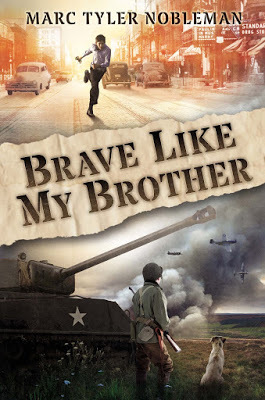Marc Tyler Nobleman's Blog, page 55
December 31, 2015
Making the case that Bill Finger deserved co-creator status
What a year.
As anyone with a Gotham stamp in his passport knows, September brought big Batman news.
Eight years have passed since I discovered that Bill Finger had a grandchild born two years after he died, Athena. When she decided to challenge the “Batman created by Bob Kane” credit line, I pulled information from my research that I thought could be relevant to the mission:
“Now that my longtime friend and collaborator is gone, I must admit that Bill never received the fame and recognition he deserved. He was an unsung hero. Because he came into the strip after I had created Batman, he did not get a by-line... I never thought of giving him a by-line and he never asked for one. I often tell my wife ‘If I could go back 15 years, before he died, I would like to say “I’ll put your name on it now, you deserve it.”’”—Bob Kane, Batman & Me, 1989 “Legally, nothing has to be done. Morally, I think something should be done, and we will do it out of compassion.”—Jay Emmett, Executive VP of Warner Communications, parent company of National Periodical Publications, on giving Superman creators Siegel and Shuster compensation and credit, October 1975Bill by present and past DC professionals in good standinginstances where DC has credited Bill for writing Batman’s origin (of course, one of the most significant aspects of the character)Jerry Robinson in 2006: “[Bill] created most everything for [Bob]. He definitely was a full co-creator. I think he had more to do with the molding of Batman than Bob. He just did so many things at the beginning. As an artist, I can appreciate what goes into that. Aside from creating almost all the other characters, creating the whole persona, the whole temper, the history, origin of Batman. Everything. It made it a success from the beginning.”in Alter Ego #39 (1/03), Jerry Robinson said he is “positive” Robin was Bill’s ideain Batman #169 (2/65), longtime DC editor Julius Schwartz gave Bill creator sole credit for the Riddlerin Comics Interview Super Special: Batman—Real Origins of the Dark Knight (1989), Bob is quoted as saying this: “Bill Finger created some of the villains: I believe he created Penguin. Catwoman, I think he came up with”; NOTE: he also then claims he (Bob) came up with Joker and Riddler, both of whom are almost always credited partially or fully to Billin Greatest Batman Stories Ever Told (1988), published by DC, Bill credited as “creator or co-creator” of Catwoman, Penguin, Riddler, Two-Face, and a “host of other elements”in Batman & Me, page 44, Bob says Bill Bill’s second wife Lyn Simmons almost getting Bill’s name in credits of first Batman movie, 1989 (particularly significant: the textual evidence that Warner Bros. almost agreed)one of DC’s most acclaimed writers, Grant Morrison, made a bold statement in Playboy (2012) —and still works for DC: “Created by: Bill Finger, art by Bob Kane (disputed)”If Bob had a contract with DC at the start of Batman, but Bob was not producing the ideas he was getting credited for, can the person who was secretly producing them make a legal claim to them?personal letter Bill wrote in 1965: “I phoned Bob Kane moment I got your copy of the fantastic letter [in which Bob claimed Bill was lying about his role in Batman]; after a few minutes of conversation in which I quite angrily spoke my mind and jogged Bob’s fading memory, he agreed to ‘revise’ the letter, in fact asked me to have dinner with him”on DC’s “75th anniversary of Batman” chronological milestone poster, the first nine elements (and 12 of the first 14) listed came solely or mostly from Billsimply comparing what Bill is credited for vs. what Bob is credited for makes it indisputably clear that Bill is the dominant creative forceTom Fagan’s 1965 article based on interview with Bill, “The Man Behind the Legend” (last line calls Bill “the” creator of Batman)signs indicate that DC does believe Bill deserves more; legally, they can’t say so themselves, but they didn’t stop me from saying so, which almost seems like a way to endorse the truth of the matter
As anyone with a Gotham stamp in his passport knows, September brought big Batman news.
Eight years have passed since I discovered that Bill Finger had a grandchild born two years after he died, Athena. When she decided to challenge the “Batman created by Bob Kane” credit line, I pulled information from my research that I thought could be relevant to the mission:
“Now that my longtime friend and collaborator is gone, I must admit that Bill never received the fame and recognition he deserved. He was an unsung hero. Because he came into the strip after I had created Batman, he did not get a by-line... I never thought of giving him a by-line and he never asked for one. I often tell my wife ‘If I could go back 15 years, before he died, I would like to say “I’ll put your name on it now, you deserve it.”’”—Bob Kane, Batman & Me, 1989 “Legally, nothing has to be done. Morally, I think something should be done, and we will do it out of compassion.”—Jay Emmett, Executive VP of Warner Communications, parent company of National Periodical Publications, on giving Superman creators Siegel and Shuster compensation and credit, October 1975Bill by present and past DC professionals in good standinginstances where DC has credited Bill for writing Batman’s origin (of course, one of the most significant aspects of the character)Jerry Robinson in 2006: “[Bill] created most everything for [Bob]. He definitely was a full co-creator. I think he had more to do with the molding of Batman than Bob. He just did so many things at the beginning. As an artist, I can appreciate what goes into that. Aside from creating almost all the other characters, creating the whole persona, the whole temper, the history, origin of Batman. Everything. It made it a success from the beginning.”in Alter Ego #39 (1/03), Jerry Robinson said he is “positive” Robin was Bill’s ideain Batman #169 (2/65), longtime DC editor Julius Schwartz gave Bill creator sole credit for the Riddlerin Comics Interview Super Special: Batman—Real Origins of the Dark Knight (1989), Bob is quoted as saying this: “Bill Finger created some of the villains: I believe he created Penguin. Catwoman, I think he came up with”; NOTE: he also then claims he (Bob) came up with Joker and Riddler, both of whom are almost always credited partially or fully to Billin Greatest Batman Stories Ever Told (1988), published by DC, Bill credited as “creator or co-creator” of Catwoman, Penguin, Riddler, Two-Face, and a “host of other elements”in Batman & Me, page 44, Bob says Bill Bill’s second wife Lyn Simmons almost getting Bill’s name in credits of first Batman movie, 1989 (particularly significant: the textual evidence that Warner Bros. almost agreed)one of DC’s most acclaimed writers, Grant Morrison, made a bold statement in Playboy (2012) —and still works for DC: “Created by: Bill Finger, art by Bob Kane (disputed)”If Bob had a contract with DC at the start of Batman, but Bob was not producing the ideas he was getting credited for, can the person who was secretly producing them make a legal claim to them?personal letter Bill wrote in 1965: “I phoned Bob Kane moment I got your copy of the fantastic letter [in which Bob claimed Bill was lying about his role in Batman]; after a few minutes of conversation in which I quite angrily spoke my mind and jogged Bob’s fading memory, he agreed to ‘revise’ the letter, in fact asked me to have dinner with him”on DC’s “75th anniversary of Batman” chronological milestone poster, the first nine elements (and 12 of the first 14) listed came solely or mostly from Billsimply comparing what Bill is credited for vs. what Bob is credited for makes it indisputably clear that Bill is the dominant creative forceTom Fagan’s 1965 article based on interview with Bill, “The Man Behind the Legend” (last line calls Bill “the” creator of Batman)signs indicate that DC does believe Bill deserves more; legally, they can’t say so themselves, but they didn’t stop me from saying so, which almost seems like a way to endorse the truth of the matter
Published on December 31, 2015 04:00
December 27, 2015
Super(hero) school library in Utah
In 10/13, I made my first trip to Utah and spoke at several schools. Author friend Chris Barton recently spoke at one of the same schools and posted/tweeted a visual update of how the library looks now:
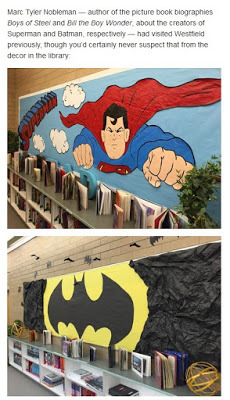
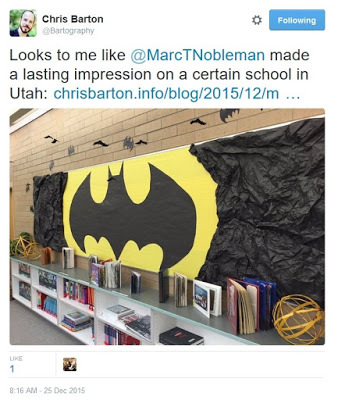


Published on December 27, 2015 04:00
December 23, 2015
Top 10 pop culture moments of 2015
#10: Bill Finger finally credited as co-creator of Batman.
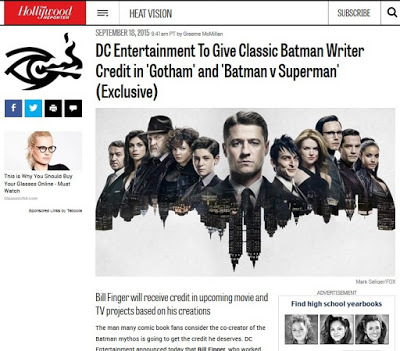 The Hollywood Reporter broke the story on 9/18/15.
The Hollywood Reporter broke the story on 9/18/15.
#9: Bill Finger finally credited as co-creator of Batman.
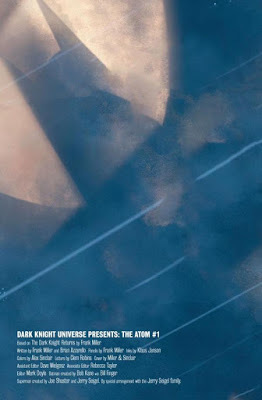
 The first credit appeared in an ad for Dark Knight Universe Presents: The Atom #1, 10/10/15.
The first credit appeared in an ad for Dark Knight Universe Presents: The Atom #1, 10/10/15.
#8: Bill Finger finally credited as co-creator of Batman.
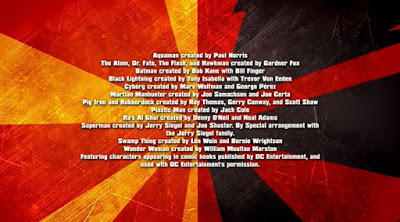 The first televised credit appeared in Robot Chicken DC Comics Special III: Magical Friendship,aired first thing 10/19/15.
The first televised credit appeared in Robot Chicken DC Comics Special III: Magical Friendship,aired first thing 10/19/15.
#7: Bill Finger finally credited as co-creator of Batman.
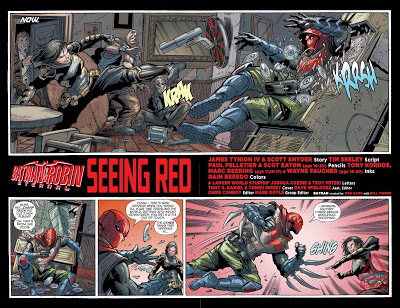 One of the first three in-comic credits appeared in Batman & Robin Eternal #3, released 10/21/15.
One of the first three in-comic credits appeared in Batman & Robin Eternal #3, released 10/21/15.
#6: Bill Finger finally credited as co-creator of Batman.
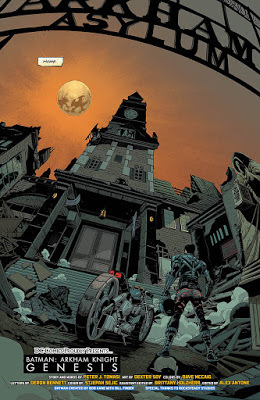 One of the first three in-comic credits appeared in Batman: Arkham Knight—Genesis #3,released 10/21/15.
One of the first three in-comic credits appeared in Batman: Arkham Knight—Genesis #3,released 10/21/15.
#5: Bill Finger finally credited as co-creator of Batman.
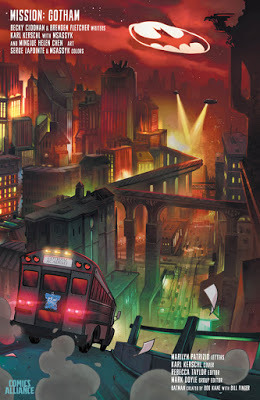 One of the first three in-comic credits appeared in Gotham Academy #11, released 10/21/15.
One of the first three in-comic credits appeared in Gotham Academy #11, released 10/21/15.
#4: Bill Finger finally credited as co-creator of Batman.
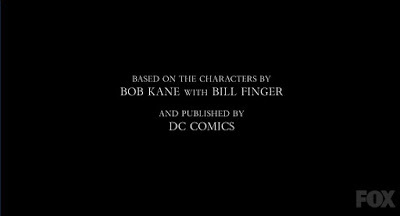 Gotham, aired 10/19/15.
Gotham, aired 10/19/15.
#3: Bill Finger finally credited as co-creator of Batman.
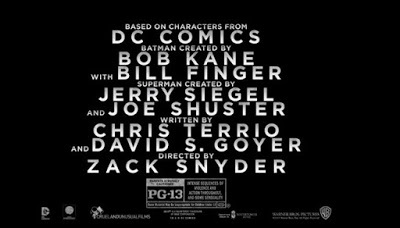 Batman v Superman: Dawn of Justice TV ad,aired 11/30/15.
Batman v Superman: Dawn of Justice TV ad,aired 11/30/15.
#2: Bill Finger finally credited as co-creator of Batman.
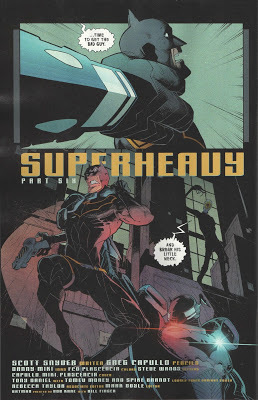 Batman #46, released 11/11/15.
Batman #46, released 11/11/15.
#1: Bill Finger finally credited as co-creator of Batman.
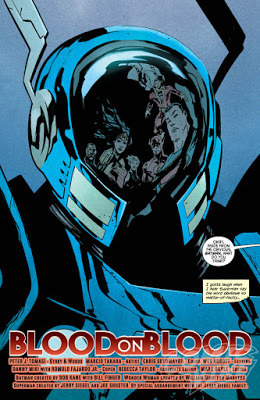 Detective Comics #46, released 11/4/15.The title in which Batman began...
Detective Comics #46, released 11/4/15.The title in which Batman began...
 The Hollywood Reporter broke the story on 9/18/15.
The Hollywood Reporter broke the story on 9/18/15.#9: Bill Finger finally credited as co-creator of Batman.

 The first credit appeared in an ad for Dark Knight Universe Presents: The Atom #1, 10/10/15.
The first credit appeared in an ad for Dark Knight Universe Presents: The Atom #1, 10/10/15.#8: Bill Finger finally credited as co-creator of Batman.
 The first televised credit appeared in Robot Chicken DC Comics Special III: Magical Friendship,aired first thing 10/19/15.
The first televised credit appeared in Robot Chicken DC Comics Special III: Magical Friendship,aired first thing 10/19/15.#7: Bill Finger finally credited as co-creator of Batman.
 One of the first three in-comic credits appeared in Batman & Robin Eternal #3, released 10/21/15.
One of the first three in-comic credits appeared in Batman & Robin Eternal #3, released 10/21/15.#6: Bill Finger finally credited as co-creator of Batman.
 One of the first three in-comic credits appeared in Batman: Arkham Knight—Genesis #3,released 10/21/15.
One of the first three in-comic credits appeared in Batman: Arkham Knight—Genesis #3,released 10/21/15.#5: Bill Finger finally credited as co-creator of Batman.
 One of the first three in-comic credits appeared in Gotham Academy #11, released 10/21/15.
One of the first three in-comic credits appeared in Gotham Academy #11, released 10/21/15.#4: Bill Finger finally credited as co-creator of Batman.
 Gotham, aired 10/19/15.
Gotham, aired 10/19/15.#3: Bill Finger finally credited as co-creator of Batman.
 Batman v Superman: Dawn of Justice TV ad,aired 11/30/15.
Batman v Superman: Dawn of Justice TV ad,aired 11/30/15.#2: Bill Finger finally credited as co-creator of Batman.
 Batman #46, released 11/11/15.
Batman #46, released 11/11/15.#1: Bill Finger finally credited as co-creator of Batman.
 Detective Comics #46, released 11/4/15.The title in which Batman began...
Detective Comics #46, released 11/4/15.The title in which Batman began...
Published on December 23, 2015 04:00
December 22, 2015
"Brave Like My Brother" a Junior Library Guild selection
Published on December 22, 2015 05:53
December 12, 2015
Addicted to lies
Within two weeks of each other, two people commented here that they each know a (different) woman who claims she was one of the five “bandmates” in the iconic 1986 “Addicted to Love” video…yet not one of the five I featured.
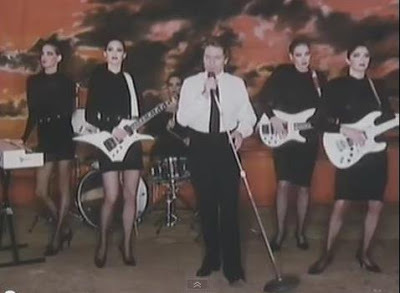
One is a high school English teacher named Anita Dowd.
The other is named Alison-Louise Mitchell.
However, I tracked down and interviewed all five women from the video, and all five know one another, and none knows the names of these other two, so it’s a rather bizarre bid for attention or…something.
From one of the five ATL ladies:
“Many have claimed otherwise, but we five are without a doubt the girls in the original ‘Addicted’ video. It’s actually quite easy to get away with claiming to be in it as the makeup is difficult to see through…until you put our faces next to our younger ones and you can see it was us.”
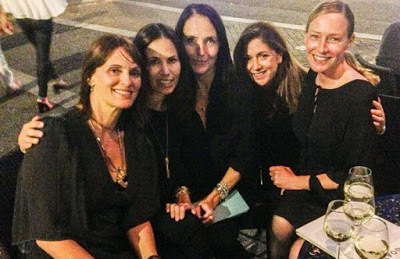 2014 reunion
2014 reunion
I couldn’t resist the title of this post, but concede that it is too harsh and maybe inaccurate. There are other explanations for these claims.
Perhaps the people posting about Anita and Alison-Louise are sincerely misremembering the reality. Perhaps those women were on set but as musicians, not models. Or perhaps they were dancers in another Robert Palmer video. Perhaps Anita and Alison-Louise did say they were ATL women, but as a joke that was taken for truth. Perhaps they were so under the influence of something in the ‘80s that they genuinely believed they were in the video. And so on.
By the way, did you spot me in Madonna’s “Vogue”?
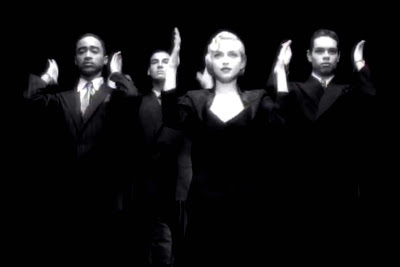

One is a high school English teacher named Anita Dowd.
The other is named Alison-Louise Mitchell.
However, I tracked down and interviewed all five women from the video, and all five know one another, and none knows the names of these other two, so it’s a rather bizarre bid for attention or…something.
From one of the five ATL ladies:
“Many have claimed otherwise, but we five are without a doubt the girls in the original ‘Addicted’ video. It’s actually quite easy to get away with claiming to be in it as the makeup is difficult to see through…until you put our faces next to our younger ones and you can see it was us.”
 2014 reunion
2014 reunionI couldn’t resist the title of this post, but concede that it is too harsh and maybe inaccurate. There are other explanations for these claims.
Perhaps the people posting about Anita and Alison-Louise are sincerely misremembering the reality. Perhaps those women were on set but as musicians, not models. Or perhaps they were dancers in another Robert Palmer video. Perhaps Anita and Alison-Louise did say they were ATL women, but as a joke that was taken for truth. Perhaps they were so under the influence of something in the ‘80s that they genuinely believed they were in the video. And so on.
By the way, did you spot me in Madonna’s “Vogue”?

Published on December 12, 2015 04:00
December 11, 2015
MTN in TN…again
For the third time this fall, I had the pleasure of going to Tennessee to talk books.
This time, over three days, I spoke once each at nine schools in the Blountville area of northeast Tennessee, not far from the Virginia border. At home in Maryland, I’m also not far from the Virginia border, but on the other end.
This trip was a model example of teamwork. Individually, many of these schools did not have the budget for an enrichment program, but there’s affordability in numbers. The inexhaustible Donna Hatcher organized all this, and in record time. For most of these schools, it was the first time a non-local author visited, so further props to Donna for convincing them of the value of such an activity. Bringing in an author can be nerve-racking for the host, especially the first time. I can’t praise the students enough; they were so respectful, as if they have assemblies weekly. Also so attentive and responsive.
During one talk, in front of an auditorium of kids, a middle schooler named Adam (who is on the spectrum) walked calmly up to me, kissed his palm, and touched it to my cheek, then silently walked to the back of the room. I love that he was struck with the feeling to do this, and I love that the teachers let him. It rendered me speechless for longer than a dramatic pause.
Toward the end of my talk for older kids, I say that Bill Finger’s son Fred was gay. My presentation is an exercise in economy—every word is there to drive the drama of the story—and this detail is no different. In an area as conservative as rural Tennessee, however, the risk of this causing concern is considerable.
At a couple of schools, my kind hosts raised this issue with me privately—and professionally. One host apologized that students asked multiple questions about Fred’s sexuality (“How could he have a child if he was gay?”; “What is AIDS?”). I assured her that this was nothing to apologize for—quite the opposite. The questions were perfectly valid—and I commend the students who felt comfortable to ask them, especially in a room packed with peers of varying levels of understanding/tolerance. Perhaps some kids have no other open channel to pose such questions. Perhaps some are already coming to terms with their own sexuality and are petrified that it is not in line with the expectation of many people they know. If a school staff, however enlightened, can’t touch on this vital topic without fear of complaints, I say let a guest take it on.
My hosts were not expressing their personal opinion or judging mine. They were simply trying to be sensitive to their community. If any parent (or fellow educator) is displeased with a guest speaker broaching a particular subject, the person who will bear the brunt of any pushback is the host. Of course I do not want to put any of my hosts in a difficult situation. At the same time, I do not want to disrespect the truth or compromise my beliefs. The solution, to me, is plainspoken compassion.
I especially applaud the librarians who had seen my talk at TASL, knew I would mention this, and still invited me; that took courage, and it was in the best interest of your young people.
In short, I feel my time in Blountville was a growth experience for all involved. I am looking forward to going back.
Glimpses:

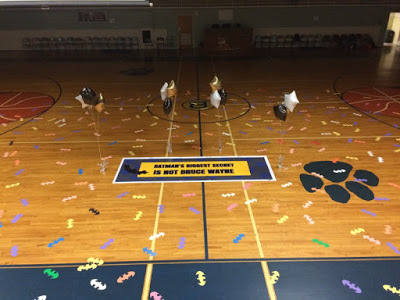
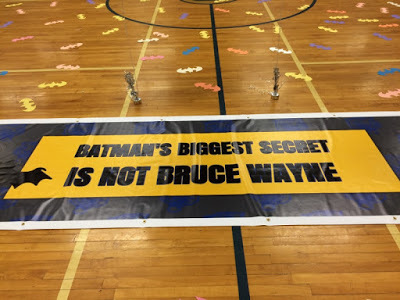 This larger-than-me banner was designed by the sixth gradeof Blountville Middle School.
This larger-than-me banner was designed by the sixth gradeof Blountville Middle School.
The Mary Hughes School library is in the process of incorporating a snazzy
Hardy Boys theme, complete with 1970s dolls and games snagged off ebay
(next three photos):
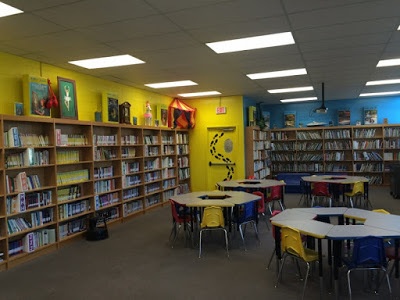
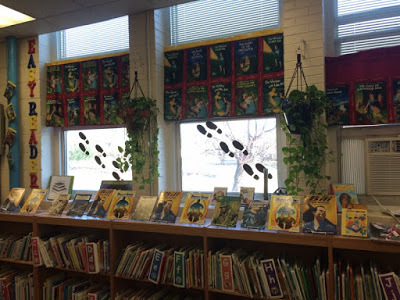
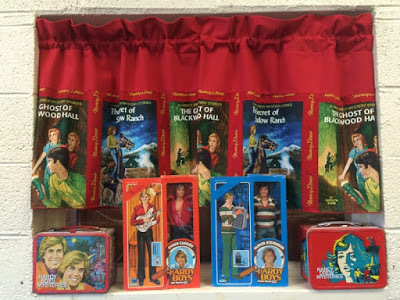
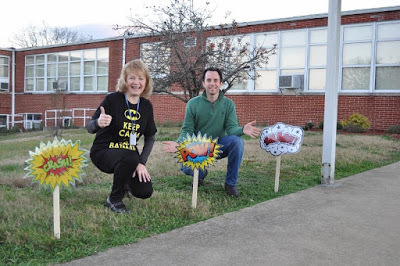
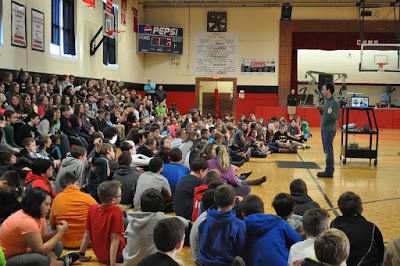
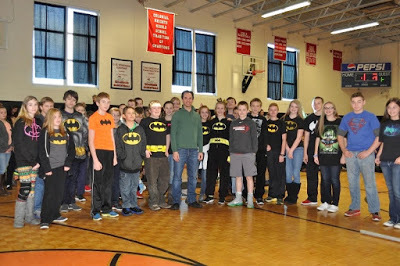
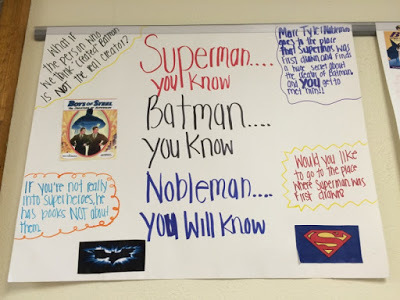
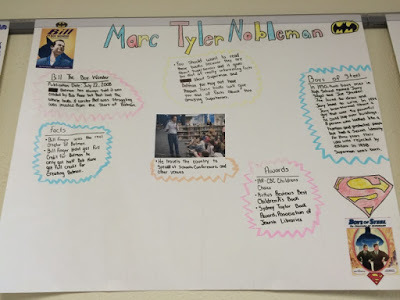
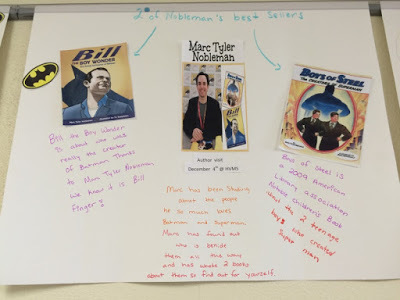
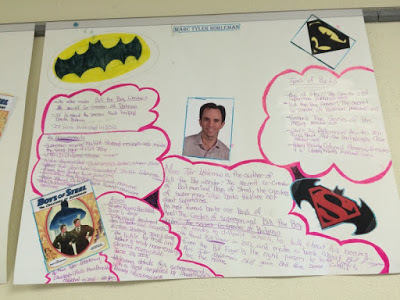
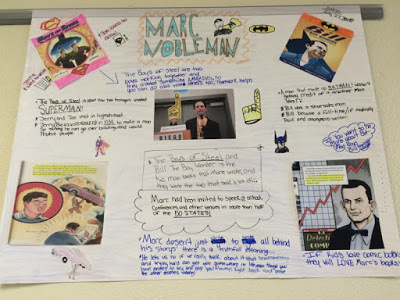
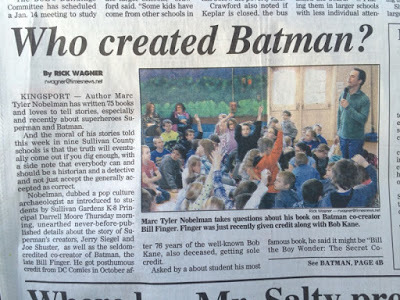
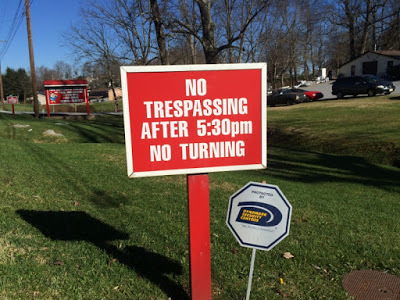 Morning and afternoon trespassing, however, is fine.
Morning and afternoon trespassing, however, is fine.
This time, over three days, I spoke once each at nine schools in the Blountville area of northeast Tennessee, not far from the Virginia border. At home in Maryland, I’m also not far from the Virginia border, but on the other end.
This trip was a model example of teamwork. Individually, many of these schools did not have the budget for an enrichment program, but there’s affordability in numbers. The inexhaustible Donna Hatcher organized all this, and in record time. For most of these schools, it was the first time a non-local author visited, so further props to Donna for convincing them of the value of such an activity. Bringing in an author can be nerve-racking for the host, especially the first time. I can’t praise the students enough; they were so respectful, as if they have assemblies weekly. Also so attentive and responsive.
During one talk, in front of an auditorium of kids, a middle schooler named Adam (who is on the spectrum) walked calmly up to me, kissed his palm, and touched it to my cheek, then silently walked to the back of the room. I love that he was struck with the feeling to do this, and I love that the teachers let him. It rendered me speechless for longer than a dramatic pause.
Toward the end of my talk for older kids, I say that Bill Finger’s son Fred was gay. My presentation is an exercise in economy—every word is there to drive the drama of the story—and this detail is no different. In an area as conservative as rural Tennessee, however, the risk of this causing concern is considerable.
At a couple of schools, my kind hosts raised this issue with me privately—and professionally. One host apologized that students asked multiple questions about Fred’s sexuality (“How could he have a child if he was gay?”; “What is AIDS?”). I assured her that this was nothing to apologize for—quite the opposite. The questions were perfectly valid—and I commend the students who felt comfortable to ask them, especially in a room packed with peers of varying levels of understanding/tolerance. Perhaps some kids have no other open channel to pose such questions. Perhaps some are already coming to terms with their own sexuality and are petrified that it is not in line with the expectation of many people they know. If a school staff, however enlightened, can’t touch on this vital topic without fear of complaints, I say let a guest take it on.
My hosts were not expressing their personal opinion or judging mine. They were simply trying to be sensitive to their community. If any parent (or fellow educator) is displeased with a guest speaker broaching a particular subject, the person who will bear the brunt of any pushback is the host. Of course I do not want to put any of my hosts in a difficult situation. At the same time, I do not want to disrespect the truth or compromise my beliefs. The solution, to me, is plainspoken compassion.
I especially applaud the librarians who had seen my talk at TASL, knew I would mention this, and still invited me; that took courage, and it was in the best interest of your young people.
In short, I feel my time in Blountville was a growth experience for all involved. I am looking forward to going back.
Glimpses:


 This larger-than-me banner was designed by the sixth gradeof Blountville Middle School.
This larger-than-me banner was designed by the sixth gradeof Blountville Middle School.The Mary Hughes School library is in the process of incorporating a snazzy
Hardy Boys theme, complete with 1970s dolls and games snagged off ebay
(next three photos):












 Morning and afternoon trespassing, however, is fine.
Morning and afternoon trespassing, however, is fine.
Published on December 11, 2015 04:00
December 8, 2015
“Super Friends” DVD oddities
I know, what’s a DVD?
Whether or not you know the term, perhaps you can solve two mysteries presented by the packaging of the DVDs of All-New Super Friends Hour (season 1, volume 2).
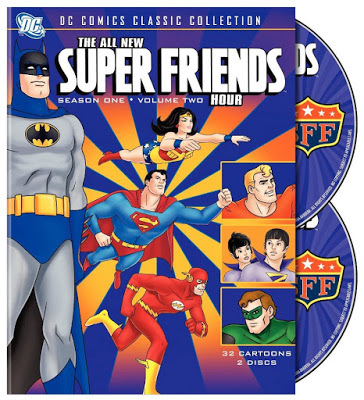
Mystery #1:
When did this happen?
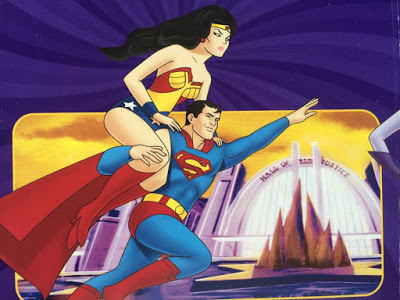
Mystery #2:
What is the second “F” for (left disc from another DVD set, for comparison)?
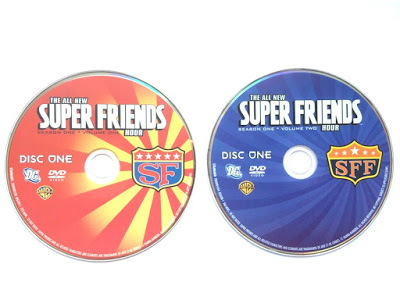
Possible answer: “forever” (as in “Super Friends Forever”)?
Whether or not you know the term, perhaps you can solve two mysteries presented by the packaging of the DVDs of All-New Super Friends Hour (season 1, volume 2).

Mystery #1:
When did this happen?

Mystery #2:
What is the second “F” for (left disc from another DVD set, for comparison)?

Possible answer: “forever” (as in “Super Friends Forever”)?
Published on December 08, 2015 04:00
December 4, 2015
Desk desk evolution
Who takes a picture of his desk?
Uh…
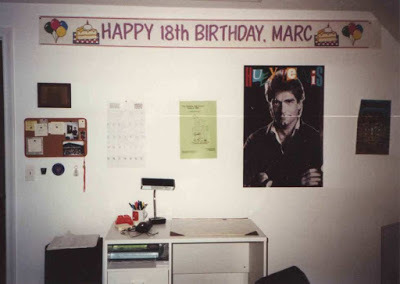 1990
1990
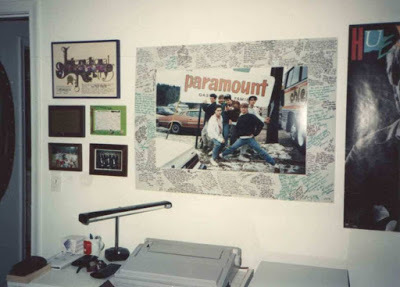 1992
1992
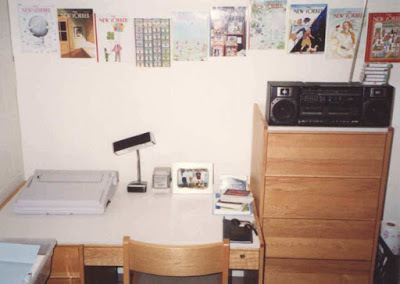 1992 (college)
1992 (college)
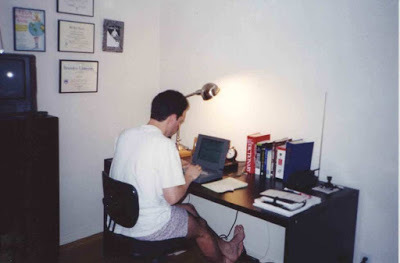 1998
1998
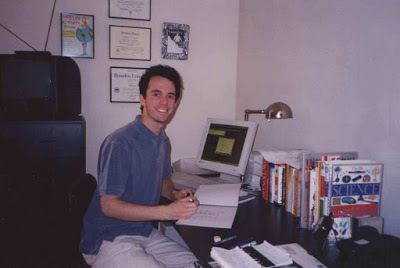 1999
1999
 2008(starting here, look for Bill Finger’s paperweight;the books on the left on the flatbed scanner werereferences for Fairy Spell)
2008(starting here, look for Bill Finger’s paperweight;the books on the left on the flatbed scanner werereferences for Fairy Spell)
 2011
2011
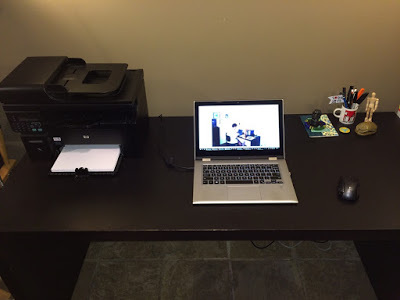 2015
2015
And just because who would have thought such a photo a) was ever taken and b) would still be around today…
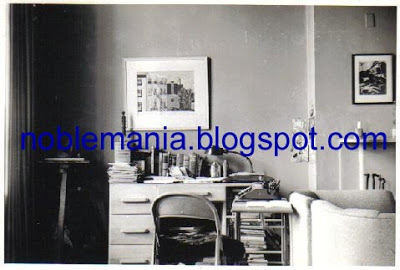 BILL FINGER’S DESK, circa 1945
BILL FINGER’S DESK, circa 1945
Uh…
 1990
1990 1992
1992 1992 (college)
1992 (college) 1998
1998 1999
1999 2008(starting here, look for Bill Finger’s paperweight;the books on the left on the flatbed scanner werereferences for Fairy Spell)
2008(starting here, look for Bill Finger’s paperweight;the books on the left on the flatbed scanner werereferences for Fairy Spell)
 2011
2011 2015
2015And just because who would have thought such a photo a) was ever taken and b) would still be around today…
 BILL FINGER’S DESK, circa 1945
BILL FINGER’S DESK, circa 1945
Published on December 04, 2015 04:00
December 2, 2015
First Bill Finger credit in a film
Published on December 02, 2015 20:17
December 1, 2015
“FairyTale: A True Story” (1997 film)
In 1917, alleged fairies captured on film fanned a firestorm of public attention. Eighty years later, they made it to film again—as in movie.
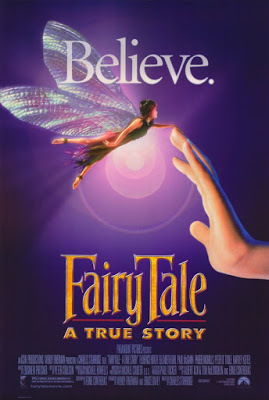
FairyTale: A True Story was the first big-screen adaptation of two WWI-era British cousins named Frances and Elsie and the five fairy photographs they snapped over three years. There is so much lovely about it. In honor of Fairy Spell, my 2018 book about the same, I will be running original interviews with the stars and story architects of FairyTale.
In the meantime, a few notes on how the film compares with the actual story (some of this will come up again in the interviews):
It is unusual for a film to claim itself “a true story” rather than “based on a true story,” especially when the film takes considerable liberties (as this one does).In the film, Elsie is 12, Frances 8; in real life, Elsie was 16 and Frances 9 when they took the first photo.In the film, Frances’s mother Annie is dead; in the actual story, she accompanied Frances to Cottingley and also lived with the Wrights.The first scene focuses on the always-captivating Harry Houdini. However, he had no role in the actual story (which is plenty captivating without him). Later in the film, Houdini is used to implant Elsie with the conviction that it’s okay to keep secrets.Elsie did not have a brother, but the film gives her one—Joseph, who has died before the story starts. He is used to implant Elsie’s mother Polly with a “realistic” motive to believe in the unknown.In the film, Frances sneaks her uncle’s camera to take the first photo; in real life, she and Elsie asked and were begrudgingly given permission to borrow it.In the real story, Arthur Conan Doyle did not meet the girls.In the real story, Polly did not meet Gardner till 1920, by which time the girls had taken two photos.In the real story, it was not Gardner who accompanied the girls to the beck to try for more photos; it was a man named Geoffrey Hodson. In the film, Gardner is present when the girls take the third (of five) photos, which occurred in 1920.The film incorporates the story of Peter Pan and its familiar element of encouraging children to believe in fairies.In the film, a reporter who breaks into the Wright home discovers the fairy cutouts (and sees the ghost of Joseph). Neither happened in real life.The film does not conclusively reveal how the girls staged photos.

FairyTale: A True Story was the first big-screen adaptation of two WWI-era British cousins named Frances and Elsie and the five fairy photographs they snapped over three years. There is so much lovely about it. In honor of Fairy Spell, my 2018 book about the same, I will be running original interviews with the stars and story architects of FairyTale.
In the meantime, a few notes on how the film compares with the actual story (some of this will come up again in the interviews):
It is unusual for a film to claim itself “a true story” rather than “based on a true story,” especially when the film takes considerable liberties (as this one does).In the film, Elsie is 12, Frances 8; in real life, Elsie was 16 and Frances 9 when they took the first photo.In the film, Frances’s mother Annie is dead; in the actual story, she accompanied Frances to Cottingley and also lived with the Wrights.The first scene focuses on the always-captivating Harry Houdini. However, he had no role in the actual story (which is plenty captivating without him). Later in the film, Houdini is used to implant Elsie with the conviction that it’s okay to keep secrets.Elsie did not have a brother, but the film gives her one—Joseph, who has died before the story starts. He is used to implant Elsie’s mother Polly with a “realistic” motive to believe in the unknown.In the film, Frances sneaks her uncle’s camera to take the first photo; in real life, she and Elsie asked and were begrudgingly given permission to borrow it.In the real story, Arthur Conan Doyle did not meet the girls.In the real story, Polly did not meet Gardner till 1920, by which time the girls had taken two photos.In the real story, it was not Gardner who accompanied the girls to the beck to try for more photos; it was a man named Geoffrey Hodson. In the film, Gardner is present when the girls take the third (of five) photos, which occurred in 1920.The film incorporates the story of Peter Pan and its familiar element of encouraging children to believe in fairies.In the film, a reporter who breaks into the Wright home discovers the fairy cutouts (and sees the ghost of Joseph). Neither happened in real life.The film does not conclusively reveal how the girls staged photos.
Published on December 01, 2015 04:00

